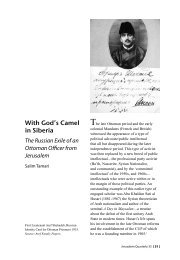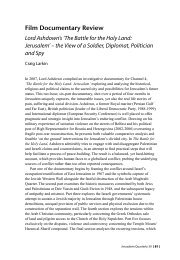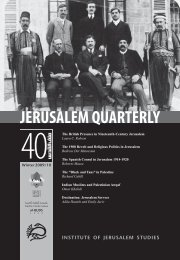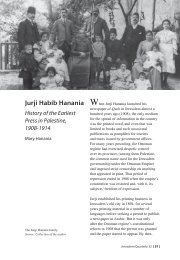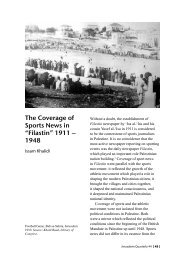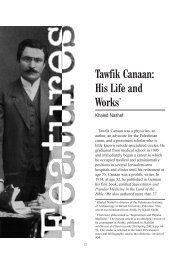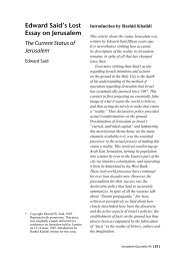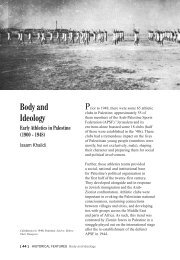PLUNDERING PALESTINE - Jerusalem Quarterly
PLUNDERING PALESTINE - Jerusalem Quarterly
PLUNDERING PALESTINE - Jerusalem Quarterly
You also want an ePaper? Increase the reach of your titles
YUMPU automatically turns print PDFs into web optimized ePapers that Google loves.
for the fifth draft on Palestinian Cultural Heritage Legislation 2003 currently under<br />
review, is very similar to the AO 1929. The 1966 law declares that antiquities are<br />
considered the property of the state. Provisions for the export of and dealing in<br />
antiquities are almost identical to the AO 1929, although the fines and penalties for<br />
criminal offenses are substantially increased.<br />
Since 1967, the West Bank and the Gaza Strip have been subject to an occupying<br />
military government, with military commanders in each area empowered with<br />
administrative, governmental, and legislative powers. These powers were executed<br />
through a series of Military Orders, two of which directly affected cultural heritage.<br />
In 1973, the Israeli occupation authorities in the Gaza Strip introduced Military Order<br />
No. 462 (1973). The order forbids the sale or transfer of any antiquity to a person who<br />
does not reside in the Gaza Strip, without permission from the director of the DOA.<br />
Permission might be granted with respect to a class of objects (Article 1); the order<br />
also created a new criminal offense for anyone violating this provision. As they were<br />
instructed under the AO 1929, dealers in antiquities are required to keep a register of<br />
the items in each shop, and failure to comply results in a financial penalty.<br />
In 1986, the Israeli occupying forces introduced another military order (No. 1166),<br />
this one concerning antiquities in the West Bank. This order amended the Jordanian<br />
Temporary Law No. 51 on Antiquities of 1966 and authorized the Israeli antiquities<br />
staff officer for the West Bank to exercise most of the regulations contained in the<br />
Jordanian law. In order to export any antiquities from the region (i.e., the West Bank)<br />
permission must be granted by the antiquities staff officer (Military Order No. 1166,<br />
1986: Article 7).<br />
An interesting element in each of these military orders (nos. 462 and 1166) covers<br />
the export of antiquities, which now requires a permit from the occupying authority.<br />
Previous legislation in the Gaza Strip and the West Bank (AO 1929) required that an<br />
export permit be obtained for each individual artefact, rather than a blanket export<br />
license as is required under the new military orders. This effectively weakens the laws.<br />
The provisions of these military orders thus may actually facilitate the movement<br />
of archaeological material across the borders for eventual sale in the legal market in<br />
Israel. Recent reports indicate that the ease of movement of archaeological material<br />
from the West Bank into the legal market in Israel in the late 1980s/early 1990s<br />
allowed for some dealers to ‘legally’ replenish their dwindling stock. 26<br />
Legislation in Israel<br />
After years of discussion and wrangling, an Israeli antiquities law was finally enacted<br />
in 1978 (AL 1978). An examination of the IAA archives uncovered correspondence<br />
concerning the drafting of legislation and the long process of negotiation in order to<br />
arrive at an antiquities law that satisfied most of the actors in the antiquities network. 27<br />
[ 28 ] FEATURES The Trade in Palestinian Antiquities



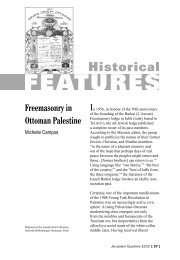
![In Search of Jerusalem Airport [pdf] - Jerusalem Quarterly](https://img.yumpu.com/49007736/1/180x260/in-search-of-jerusalem-airport-pdf-jerusalem-quarterly.jpg?quality=85)

